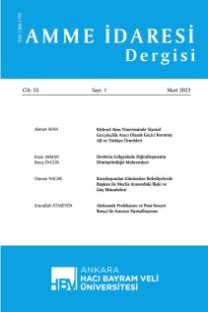Türkiye’de Ne Eğitimde Ne İstihdamda Olan Gençlerin Sosyo-Demografik Yapısı ve İşgücü Piyasası ile Bağlantısı
Bu çalışmanın amacı, Türkiye’de ne eğitimde ne istihdamda olan gençlerin (NENİ) sosyo-demografik özelliklerini ve işgücü piyasalarına girişlerini engelleyen nedenleri irdelemektir. Bu amaçla çalışmada TÜİK 2017 Hanehalkı İşgücü Anketi mikro verileri kullanılarak, 15-29 yaş grubu gençlerden NENİ olanların akranı diğer gençlerle sosyodemografik farkları çapraz tablolar ve Pearson Ki-kare testi ile gösterilmiştir. Ayrıca NENİ grubunun kendi içindeki farklılıkları ve işgücü piyasasıyla ilişkileri açıklanmıştır. Sonuçlar, Türkiye’de kadınların ev eksenli roller nedeniyle işgücü piyasasından çekilirken, erkeklerin emek piyasasına bağlı nedenler ile sağlık problemlerinden dolayı NENİ durumuna geldiğini göstermektedir.
The Socio-Demographic Structure of Young People Not in Education, Employment or Training and Their Connection with the Labour Market in Turkey
The aim of this study is to explain socio-demographic characteristics of young people who not in education, employment or training (NEET) and reasons preventing their entry into labour market in Turkey. For this purpose, by using Household Labour Force Survey microdata set of TURKSTAT 2017, socio demographic differences of NEET group with other peers have shown with cross tables and Pearson Chi-squared tests. The results show that while women are slipping out of the labour market due to taking home-based roles, men become NEET because of the labour market related problems and personal health issues.
___
- Berloffa G., E. Matteazzi ve P. Villa (2016). Family Background and Youth Labour Market Outcomes Across Europe, ECINEQ 2016-393, Working Paper.
- Blinova, T. V. ve A. A. Vial’shina (2017). “Youth Not in the Educational System and Not Employed”. Sociological Research, 56(5), 348-362. DOI: 10.1080/10610154.2017.1393208.
- Bruno, GSF, E. Marelli ve M. Signorelli (2014). “The Rise of NEET and Youth Unemployment in EU Regions after the Crisis”. Comparative Economic Studies, 56(4), 592-615.
- Coles, B., S. Hutton, J. Bradshaw, G. Craig, C. Godfrey ve J. Johnson (2002). Literature Review of the Costs of Being ‘Not in Education, Employment or Training’ at Age 16-18. Research Report 347. Norwich: Department for Education and Skills.
- Dama, N. (2017). Türkiye’nin Eğitim, Öğrenim ve Çalışma Sürecinde Olmayan Gençleri. SETA, Sayı 198.
- Eurofound (2012). NEETs-Young people not in employment, education or training: Characteristics, costs and policy responses in Europe. Publications Office of the European Union, Luxembourg.
- Eurofound (2016). Exploring the diversity of NEETs. Publications Office of the European Union, Luxembourg.
- Eurostat (2015). https://ec.europa.eu/eurostat/documents/2995521/7590616/3- 11082016-AP-EN.pdf/c0393ef3-2ea1-455a-ab64-2271c41fd9d4 (25.02.2020).
- Furlong, A. (2006). “Not a very NEET solution: Representing problematic labour market transitions among early school-leavers”. Work, Employment and Society, 20, 553–569.
- Gregg, P. ve E. Tominey (2005). “The Wage Scar from Male Youth Unemployment”. Labour Economics, 12(4), 487-509. https://doi.org/10.1016/j. labeco.2005.05.004.
- ILO (2013). Decent work indicators: guidelines for producers and users of statistical and legal framework indicators: ILO manual. Second version, International Labour Office. Geneva: ILO, https://www.ilo.org/wcmsp5/groups/public/--- dgreports/---stat/documents/publication/wcms_223121.pdf (26.02.2020).
- Işık, V. (2016). “Türkiye’de Genç İşsizliği ve Genç Nüfusta Atalet”. Hak İş Uluslararası Emek ve Toplum Dergisi, 5(11), 130-145.
- Kalkınma Bakanlığı (2019). On Birinci Kalkınma Planı (2019-2032): İşgücü Piyasası ve Genç İstihdamı, ÖİK Raporu, Ankara.
- Kılıç, Y. (2014). “Türkiye’de Ne Eğitimde Ne İstihdamda Ne de Yetiştirmede (NEİY) Yer Alan Gençler”. Eğitim ve Bilim, 39(175), 121-135.
- Kılıç, D. ve S. Öztürk (2014). “Türkiye’de Kadınların İşgücüne Katılımı Önündeki Engeller ve Çözüm Yolları: Bir Ampirik Uygulama”. Amme İdaresi Dergisi, 47(1), 107-130.
- OECD (2016). Society at a Glance 2016: OECD Social Indicators, OECD Publishing, Paris. http://dx.doi.org/10.1787/9789264261488-en.
- OECD (2019). Education at a Glance 2019: OECD Indicators. OECD Publishing, Paris. https://doi.org/10.1787/f8d7880d-en.
- OECD (2020). Youth not in employment education or training (NEET) (indicator). DOI: 10.1787/72d1033a-en.
- Özen Atabey, A. (2019). “Gençlik Garanti Programı Doğrultusunda Ne Eğitimde Ne Istihdamda Ne De Yetiştirmede Yer Alan Gençler (NEIY) Sorununa Çözüm Önerileri”. Journal of Social and Humanities Sciences Research, 6(43), 3054- 3063, doi.org/10.26450/jshsr.1469.
- Sissons, P. ve K. Jones (2012). Lost in Transition? The Changing Labour Market and Young People Not in Employment, Education or Traning. The Work Fundation.
- Susanlı, Z. B. (2016). “Understanding The NEET in Turkey”. Eurasian Journal of Economics and Finance, 4(2), 42-57. DOI: 10.15604/ejef.2016.04.02.004.
- Tamesberger D. ve J. Bacher (2014). “NEET Youth in Austria: A Typology Including Socio-demography, Labour Market Behaviour and Permanence”. Journal of Youth Studies, 17(9), 1239-1259. DOI: 10.1080/13676261.2014.901492.
- TÜİK (2019). İşgücü İstatistikleri, Kasım 2019 (Haber Bülteni).
- Uysal, G. ve U. Acar (2019). 15-19 Yaş Aralığındaki 1,3 Milyon Genç Ne Eğitimde Ne İstihdamda, Araştırma Notu 19/242. BETAM-Bahçeşehir Üniversitesi.
- Vancea, M. ve M. Utzet (2018) “School-to-work transition: the case of Spanish NEETs”. Journal of Youth Studies, 21(7), 869-887. DOI: 10.1080/13676261.2017.1421313.
- Yıldız, E. (2016). Eğitimde ve İstihdamda Yer Almayan Gençler (NEET): Avrupa Birliği Gençlik Garanti Programı ve Türkiye için Öneriler, (Uzmanlık Tezi). ÇSGB İŞKUR Genel Müdürlüğü, Ankara.
- ISSN: 1300-1795
- Yayın Aralığı: 4
- Başlangıç: 1968
- Yayıncı: -
